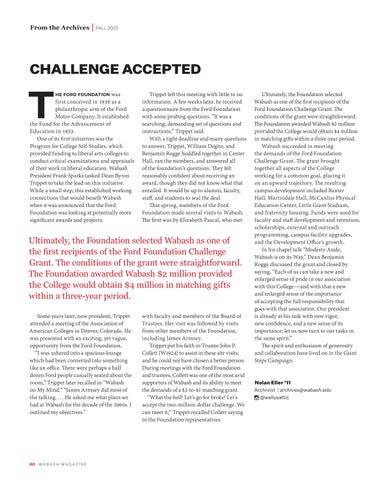From the Archives | FALL 2023
CHALLENGE ACCEPTED
T
he ford foundation was first conceived in 1936 as a philanthropic arm of the Ford Motor Company. It established the Fund for the Advancement of Education in 1953. One of its first initiatives was the Program for College Self-Studies, which provided funding to liberal arts colleges to conduct critical examinations and appraisals of their work in liberal education. Wabash President Frank Sparks tasked Dean Byron Trippet to take the lead on this initiative. While a small step, this established working connections that would benefit Wabash when it was announced that the Ford Foundation was looking at potentially more significant awards and projects.
Trippet left this meeting with little to no information. A few weeks later, he received a questionnaire from the Ford Foundation with some probing questions. “It was a searching, demanding set of questions and instructions,” Trippet said. With a tight deadline and many questions to answer, Trippet, William Degitz, and Benjamin Rogge huddled together in Center Hall, ran the numbers, and answered all of the foundation’s questions. They felt reasonably confident about receiving an award, though they did not know what that entailed. It would be up to alumni, faculty, staff, and students to seal the deal. That spring, members of the Ford Foundation made several visits to Wabash. The first was by Elizabeth Pascal, who met
Ultimately, the Foundation selected Wabash as one of the first recipients of the Ford Foundation Challenge Grant. The conditions of the grant were straightforward. The Foundation awarded Wabash $2 million provided the College would obtain $4 million in matching gifts within a three-year period. Some years later, now president, Trippet attended a meeting of the Association of American Colleges in Denver, Colorado. He was presented with an exciting, yet vague, opportunity from the Ford Foundation. “I was ushered into a spacious lounge which had been converted into something like an office. There were perhaps a half dozen Ford people casually seated about the room,” Trippet later recalled in “Wabash on My Mind.” “James Armsey did most of the talking. … He asked me what plans we had at Wabash for the decade of the 1960s. I outlined my objectives.”
80 W A B A S H M A G A Z I N E
with faculty and members of the Board of Trustees. Her visit was followed by visits from other members of the Foundation, including James Armsey. Trippet put his faith in Trustee John P. Collett [W1924] to assist in these site visits, and he could not have chosen a better person. During meetings with the Ford Foundation and trustees, Collett was one of the most avid supporters of Wabash and its ability to meet the demands of a $2-to-$1 matching grant. “What the hell! Let’s go for broke! Let’s accept the two-million-dollar challenge. We can meet it,” Trippet recalled Collett saying to the Foundation representatives.
Ultimately, the Foundation selected Wabash as one of the first recipients of the Ford Foundation Challenge Grant. The conditions of the grant were straightforward. The Foundation awarded Wabash $2 million provided the College would obtain $4 million in matching gifts within a three-year period. Wabash succeeded in meeting the demands of the Ford Foundation Challenge Grant. The grant brought together all aspects of the College working for a common goal, placing it on an upward trajectory. The resulting campus development included Baxter Hall, Martindale Hall, McCanliss Physical Education Center, Little Giant Stadium, and fraternity housing. Funds were used for faculty and staff development and retention, scholarships, external and outreach programming, campus facility upgrades, and the Development Office’s growth. In his chapel talk “Modesty Aside, Wabash is on its Way,” Dean Benjamin Rogge discussed the grant and closed by saying, “Each of us can take a new and enlarged sense of pride in our association with this College—and with that a new and enlarged sense of the importance of accepting the full responsibility that goes with that association. Our president is already at his task with new vigor, new confidence, and a new sense of its importance; let us now turn to our tasks in the same spirit.” The spirit and enthusiasm of generosity and collaboration have lived on in the Giant Steps Campaign. Nolan Eller ’11 Archivist | archives@wabash.edu @wallysattic






















